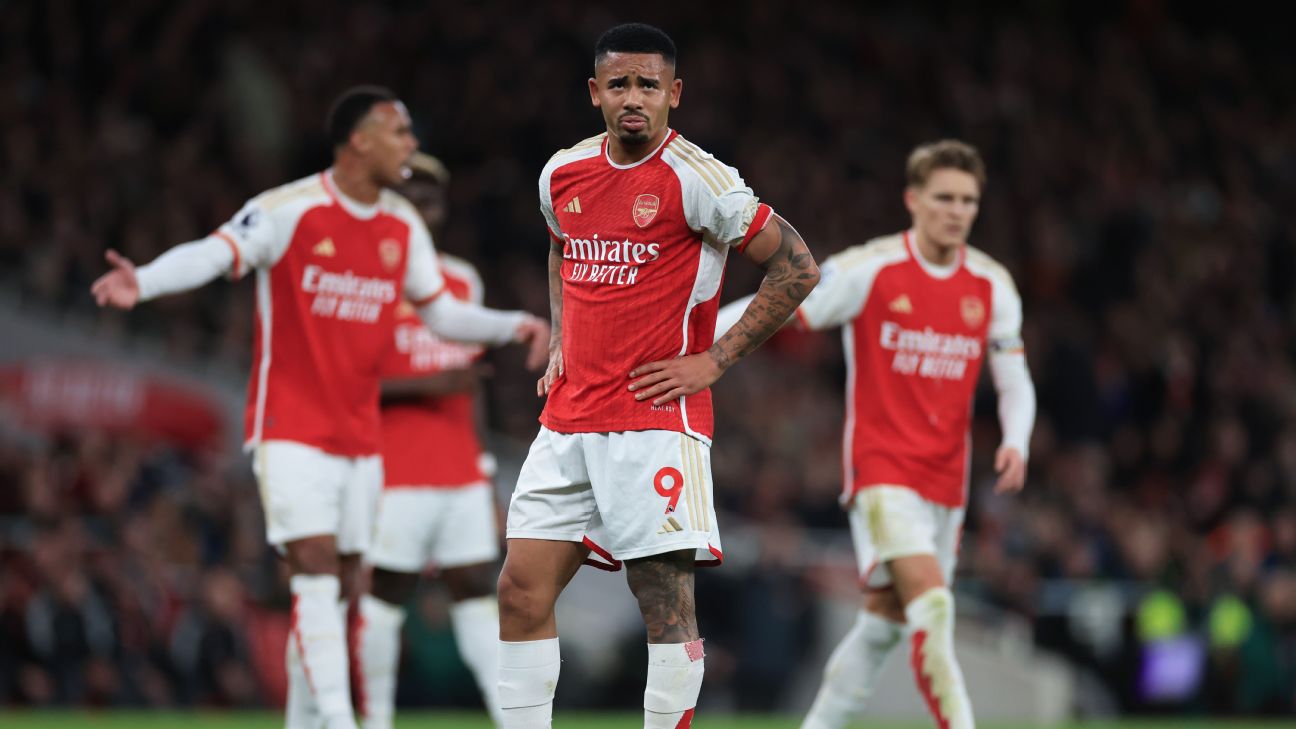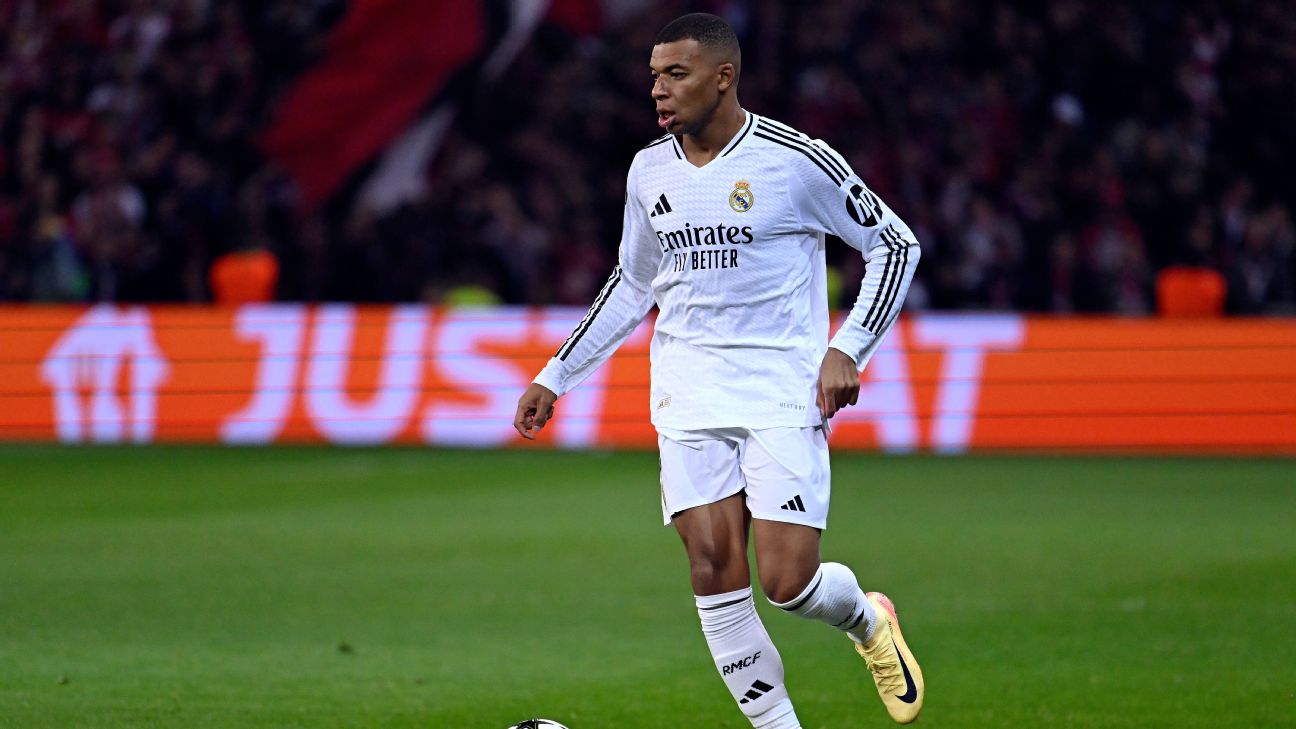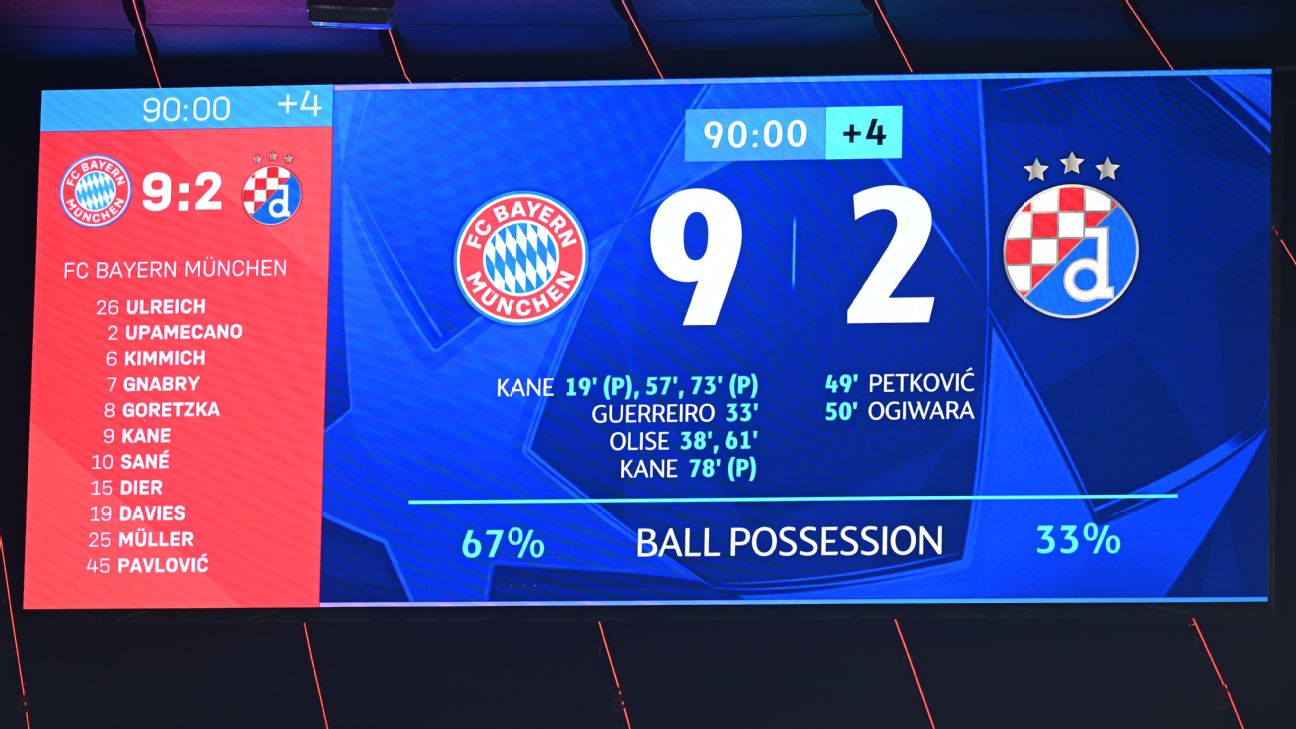Arsenal had a merry Christmas, but a happy new year? Not so much.
On Dec. 23, they went to Anfield, scored in the fourth minute and took a point against from arguably the hardest fixture on their schedule. The 1-1 draw with Liverpool ensured that the Gunners would be top of the table on Christmas, and it was a great place to be, since 10 of the previous 14 clubs who were in first on Dec. 25 also ended the season in first.
The result against Liverpool followed a dominant, should’ve-been-more-than-just-2-0 home win against Brighton. With Manchester City both struggling and falling behind in the games-played column due to the Club World Cup, Arsenal had built up a six-point lead on the three-time defending champs. What’s more, the Gunners prevented Liverpool, a point back in second, from gaining any ground from a fixture they were favored to win.
– Stream the FA Cup on ESPN+: Liverpool vs. Arsenal (Sunday, 11 a.m. ET)
You no longer needed to squint really hard or own multiple Abou Diaby jerseys in order to think that Arsenal were the favorites to win the Premier League. Per Stats Perform, they had the best expected-goal differential in the league and they had the most points in the league.
But then it all fell apart. They lost their next two matches against West Ham and Fulham. They’re five points back of Liverpool, they’re closer to fifth than first, and they’re even on points with Manchester City, who still have a game in hand against the worst team in the league. Of the last 15 points available, Arsenal have taken just four.
What went wrong? What is wrong? And could it already be too late for Arsenal to turn it all around?
So what happened to “Premier League favorites” Arsenal?
In the simplest of terms: Arsenal lost two of the easier matches on their schedule.
No two games are created equal, nor are any two schedules. While, at any given moment, the current table tells us a good deal about how the table is likely to look come the end of the year, it’s still a faulty indicator. Take last season, for example.
While there are plenty of reasons why Arsenal collapsed in the previous title race, one of the main explanations is that they ended the season with a really difficult schedule.
After April 1’s 4-1 win against Leeds United, the Gunners had built up an eight-point lead on Man City. A chunk of that was aided by the fact that City still had an extra game left to play, but a much bigger chunk was aided by the fact that Arsenal had yet to play arguably the three toughest fixtures on the schedule: away to Manchester City, away to Liverpool and away to Newcastle. Throw in a home match against Brighton, and that’s four of the best teams in the league over their final nine matches.
There likely would’ve been no epic Arsenal collapse — no factoids about how they led the league for more days than any other team that didn’t win the title — if their fixture list was in a different order. No, they simply just would’ve finished second, impressively, without any of this added emotional baggage.
What does this have to do with this season? Well, last year Arsenal beat West Ham at the Emirates, 2-1, and took down Fulham on the road, 3-0. That’s six points from six, five goals for, and one against. This season, they lost to West Ham, 2-0, and Fulham, 2-1: zero points from six, one goal for, and four against.
In order to keep pace with Liverpool and City, these are the games they need to take all three points from — not the ones that send them bouncing down the table.
OK, but why did Arsenal lose those games they should’ve won?
The West Ham match was just one of those days. Here’s a map of all the chances in the game — the bigger the circle, the bigger the xG value (expected goals) of each attempt — with the goals in green:

If anything, that undersells how dominant Arsenal were. The listed xG total — but not the graphic itself — also includes Saïd Benrahma’s 95th-minute penalty when the game was all but technically over. Without that, West Ham’s xG for the match drops down to a measly 0.63.
Maybe it doesn’t feel as if Arsenal were that dominant. West Ham basically scored with two of their three sustained attacks across the entire match. This graphic, from Stats Perform, shows the sustained possession threat for each team, calculated using a stat called “expected possession value,” which determines how likely a team is to score a goal within the next 10 seconds at any given moment:

Look at all the red for Arsenal! They weren’t just aimlessly cycling the ball around the midfield line. They generated 20 unblocked shots, their most in a match without scoring since 2015. And their 77 touches inside the penalty area were their most-ever without a goal over the past 15 seasons.
More often than not, within this exact same pattern of match, Arsenal score a couple goals, West Ham go scoreless, and no one thinks twice about what the game means. Not so for the Fulham match, though:
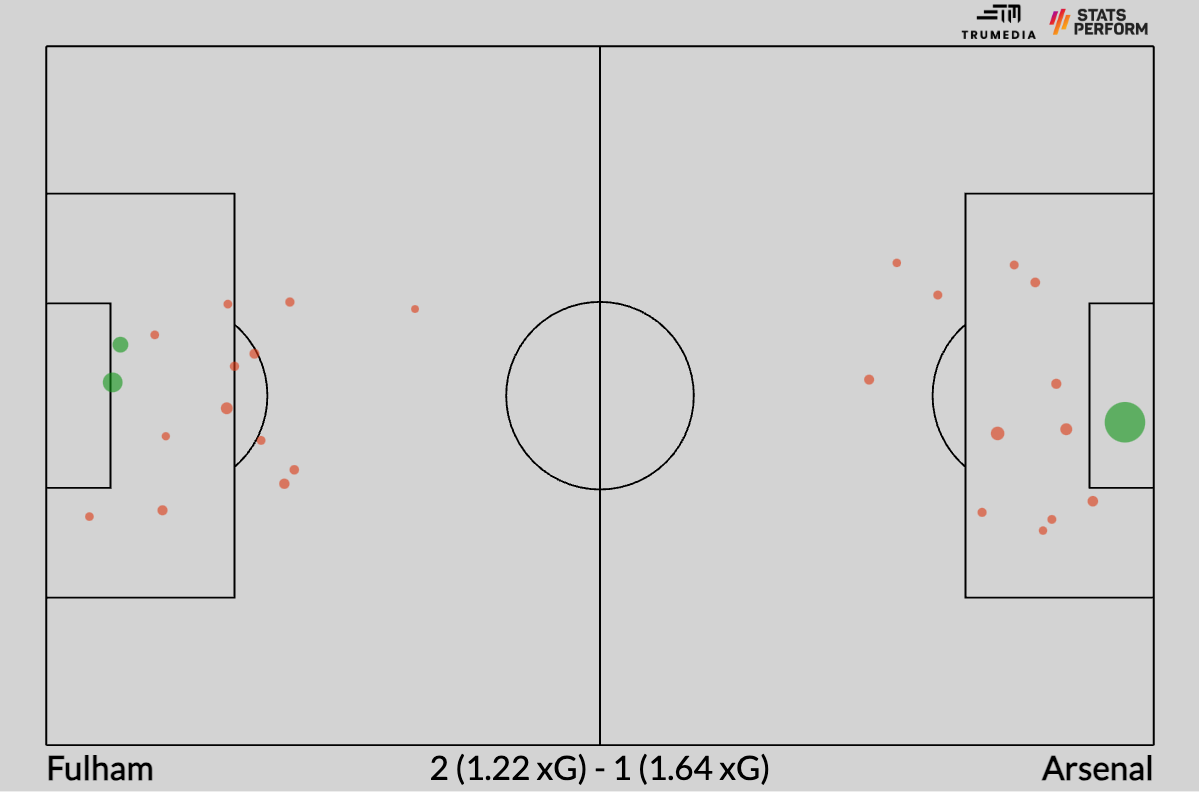
It was pretty even from a chance-creation perspective, and more worrying was Arsenal’s inability to control the match for any sustained period of time. Both teams traded blows for the entirety of the match:

Although it’s two losses in a row, it’s more like one bad performance and one freakish result. With the two matches taken together, Arsenal created 4.41 non-penalty xG and conceded 1.86. The vagaries of the bouncing ball, mainly, turned that into one goal scored for Arsenal, and four for their opponents.
But Arsenal have lost more than those two games — that’s also a problem, right?
If we extend all the way back to the Aston Villa match, it looks worse. Here’s the points-per-game table for the previous five matchdays:
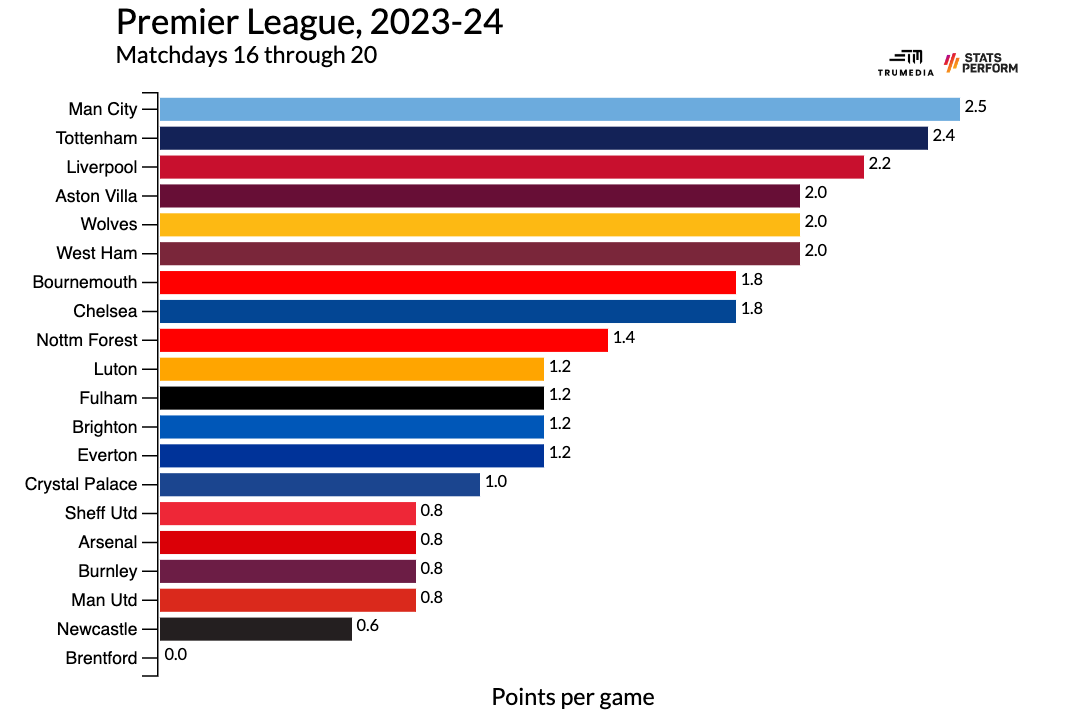
Five games is a much bigger sample size than two, and the Gunners have won as many points over the previous five matches as Burnley, Sheffield United and Manchester United. I’m not sure there are three worse teams in the Premier League with which to be mentioned in the same sentence.
However, it’s mostly the same story as above. Here’s how the table looks from those five matches, when sorted by non-penalty xG differential:

Over the past five matches, the Gunners have created 8.88 xG and only turned it into four goals. Their opponents have turned 4.08 xG into six goals.
Put another way: Over the first 15 matches, Arsenal generated a per-game non-penalty xG differential of plus-0.84 and it led to 2.4 points per game. Over the most recent five matches, the xG differential rose up to plus-0.96, while the points-per-game rate dropped down 0.8.
To review: the main reason Arsenal are currently in a so-called crisis? Soccer is random.
Aren’t Man City and Liverpool ahead of Arsenal in that xG table, though?
Yes, the other reason that Arsenal’s struggles feel so pronounced is that Liverpool and City have been lights-out over the same stretch. And here’s where I’ll point to something systemic, rather than continuing to tell you to shrug your shoulders.
At this point in the season, these three teams have close-to-identical xG differentials. Liverpool lead ever so slightly at plus-0.91, while City are at 0.90 and Arsenal are at plus-0.87. These models are not accurate enough to say confidently that a gap of 0.04 is outside of the margin for error, so we’ll just say they’re all equal. (Take out minutes played up and down a man, and Liverpool’s lead grows, but that’s a discussion for another day.)
However, each team gets there in a different way. Here’s how the whole league compares by non-penalty xG created and conceded per game:

Liverpool are, by far, the most potent attacking team in the league. The 7.2 xG created in Monday’s win over Newcastle is the most created by any team in Europe’s Big Five leagues in the entire TruMedia database, which goes back to the 2010-11 season. City remain the most balanced of the three, while Arsenal have the best defense.
The Gunners have conceded the fewest expected goals from both open-play and from set pieces. If defense wins championships, then there’s reason to remain bullish on Arsenal. Except, that statement typically applies to competitions with playoffs, where the best teams actually compete in matches against each other in order to determine the champion. But does it work, when you’re playing everyone twice, home and away, and then just adding up the points?
Arsenal writer Scott Willis looked into the idea recently and came up with a simple, elegant way of answering the question:
If we take the team with the best-ever defense of Chelsea [2004-05] (15 goals allowed) and combine that with an average attack (51 goals scored) we would expect that team to win 74 points over a season. That’s pretty good but that is a borderline top-four team rather than one that wins [the title].
Now if we take the best-ever attack of Manchester City (108 goals scored) and combine that with an average defense for goals allowed (51 goals allowed), we would expect that team to win 89 points over a season. That’s not guaranteed to win the [title] but it does get a lot closer to the title than the team with the historically best defense.
On an individual level, there are three Premier League players who are averaging at least 0.9 non-penalty expected goals and expected assists per 90 minutes so far this season. One of them plays for Manchester City (Erling Haaland), and two of them play for Liverpool (Darwin Núñez and Mohamed Salah). These are world-class numbers.
Arsenal’s leader is Leandro Trossard at 0.61, which ranks 20th in the league. He’s also only started six matches this season. Second on the team is Gabriel Jesus at 0.6 non-penalty xG+xA per 90, but he also might be one of the few players for whom the underlying numbers lie. Across seven Premier League seasons, he’s scored about 14 fewer goals than expected.
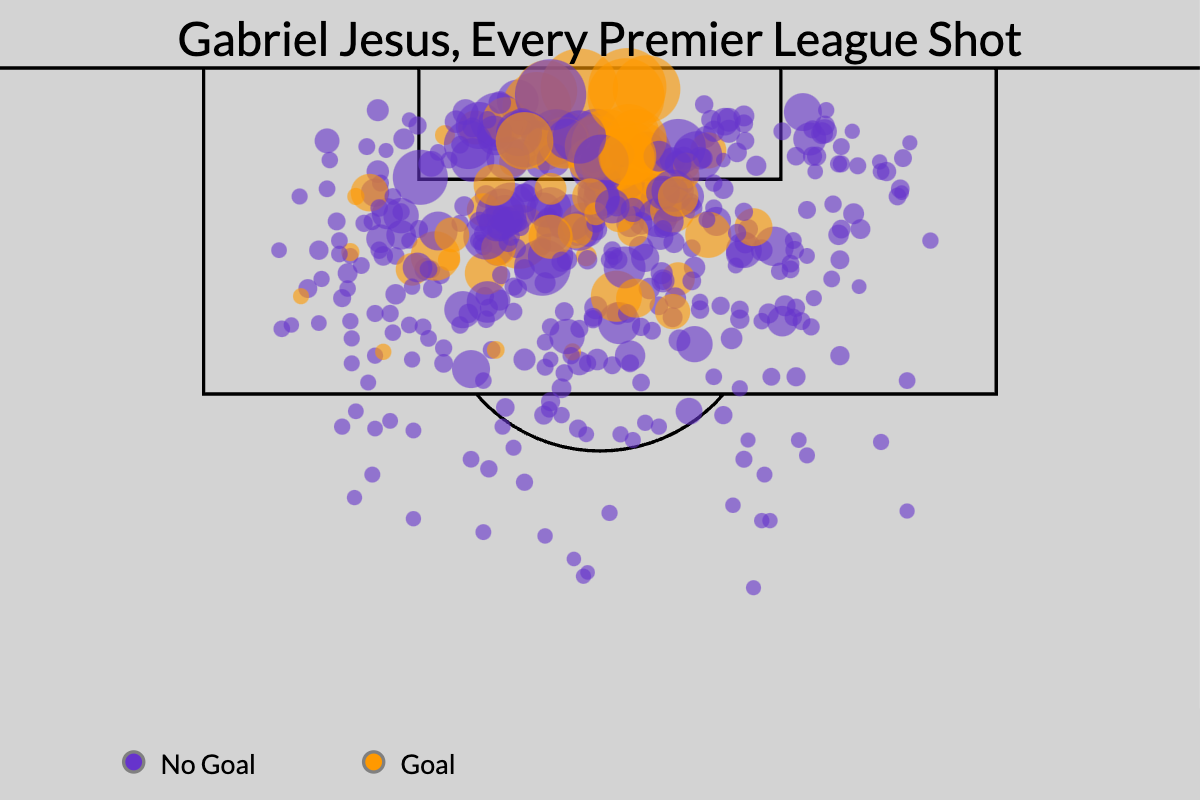
For all of his merits and his steady year-on-year improvement, Bukayo Saka has yet to produce one of those monster shot-output seasons we expect from world-class wingers on the best teams in the world. (He’s only 22.) And on the other side, Gabriel Martinelli seems to have been hamstrung by the team’s more deliberate, defense-first style. His touches in the attacking third and penalty area have gone up from last season, but his non-penalty xG+xA (expected goals, plus expected assists) rate has dropped significantly, from 0.59 down to 0.38 per 90 minutes. There are simply more defenders in the way.
Now, Manchester City shifted toward a much more defensive approach last season, and it worked because they had Erling Haaland and Kevin De Bruyne to break down the door a couple times every match without the team needing to risk too many numbers forward.
For much of this season, Arsenal’s solution has been set-piece excellence. They’re tied for the league lead with 11 goals from set plays, but that’s over selling how good they are at dead balls. They’ve created 7.28 xG from set plays, which ranks fifth in the league, and attempted 78 shots, which is tied for fourth. Without converting these dead balls into goals and forcing their opponents to open up, Arsenal have found it much harder to, well, win.
Arsenal have scored a set-piece goal in nine games, and they have 25 points from those matches — 2.8 points per game. Across the other 11 matches, they’ve taken just 15 points — 1.4 points per game, or right around where Wolverhampton and Chelsea’s current full-season pace.
Otherwise, the Gunners have created just 25.17 xG from open play — the seventh-best mark in the league, sandwiched below Brighton and above Brentford. Can that really win you the league?
So can Arsenal still win the Premier League? Or is it over?
It’s not quite over, but the last few matches show just how tight the margins are when you’re competing for a title against two of the five best teams in the world (according to the Club Elo and Opta ratings). Per the consultancy Twenty First Group’s projections, here’s how Arsenal’s title odds have shifted over the past month:

The betting markets, too, have significantly downgraded Arsenal’s chances of winning the league:
How December/January (post GW13) has gone for select clubs:
Bournemouth: +10
Everton: +6
West Ham: +5
Spurs: +4
Luton: +3
Arsenal: -4
Man Utd: -5
Brentford: -8
Newcastle: -9 pic.twitter.com/eJ4b1NgXXO— Omar Chaudhuri (@OmarChaudhuri) January 3, 2024
The main reason for the shift: some of their shots didn’t go in, while everyone else’s did. The secondary reason: the balance of the team might give them a higher floor but a lower ceiling. And one more reason: Liverpool and Manchester City are both really freaking good.
Arsenal under Mikel Arteta, then, are smashing up against the harsh reality that is this current era of soccer in England. Arsenal are better than they’ve been in a really long time. They have a great chance at winning the Champions League and could easily win the FA Cup, too. But they’re still, most likely, not going to be good enough to win the Premier League.
